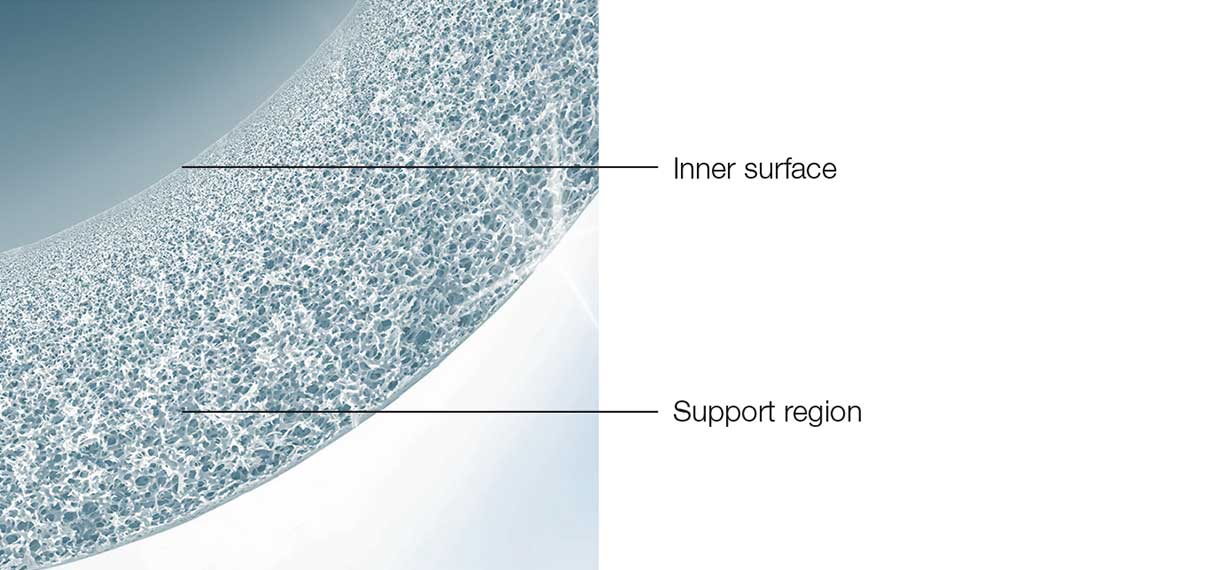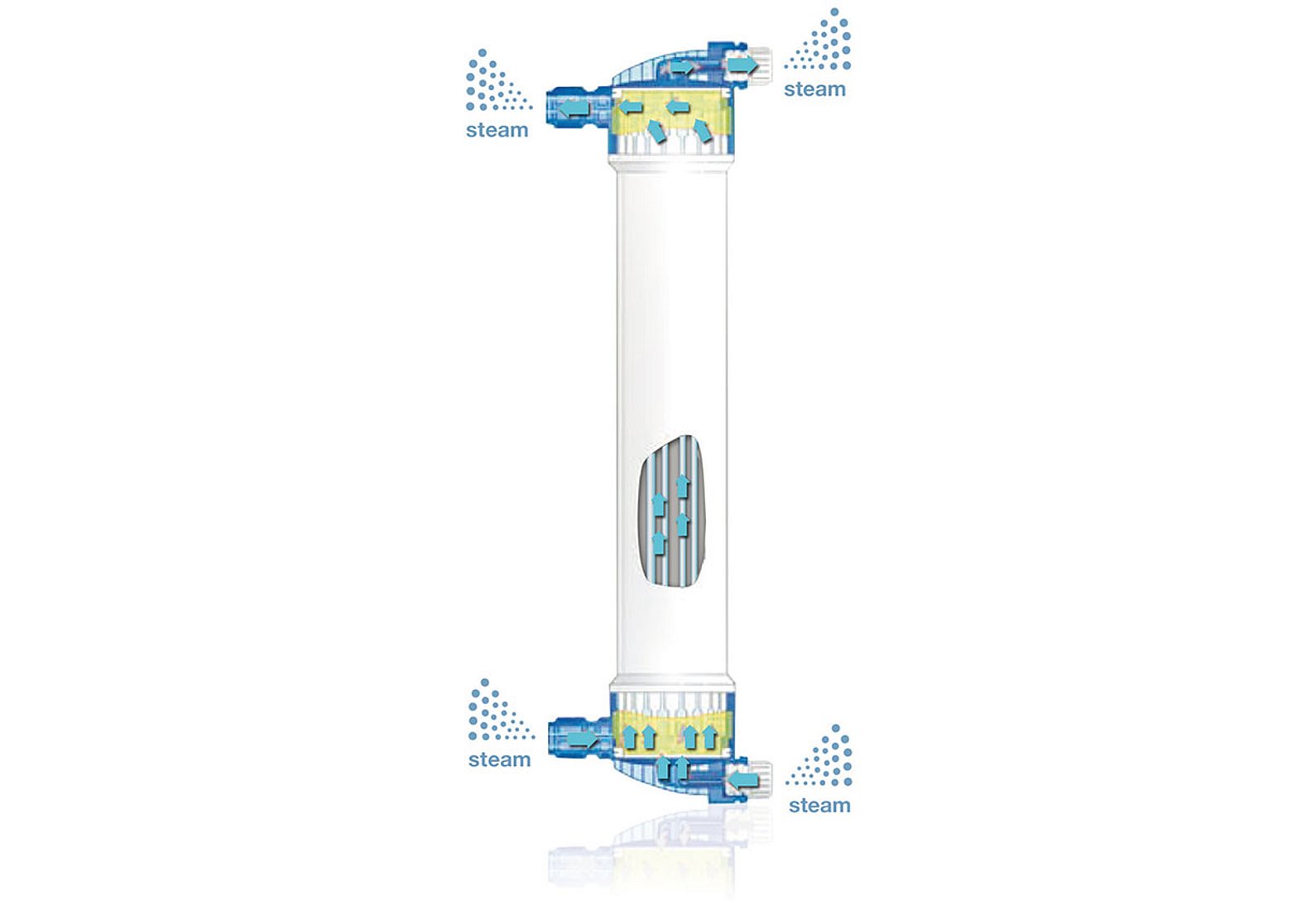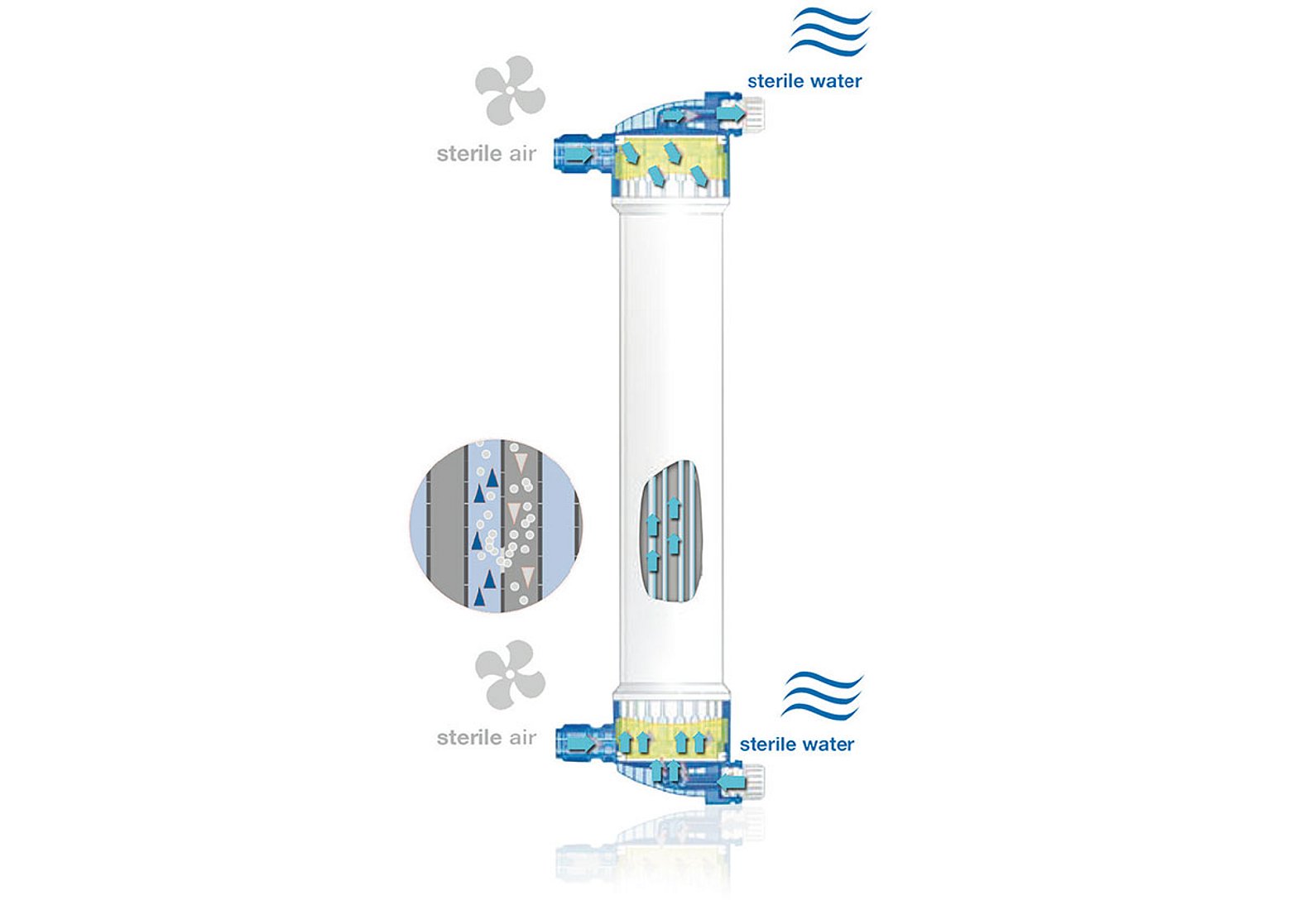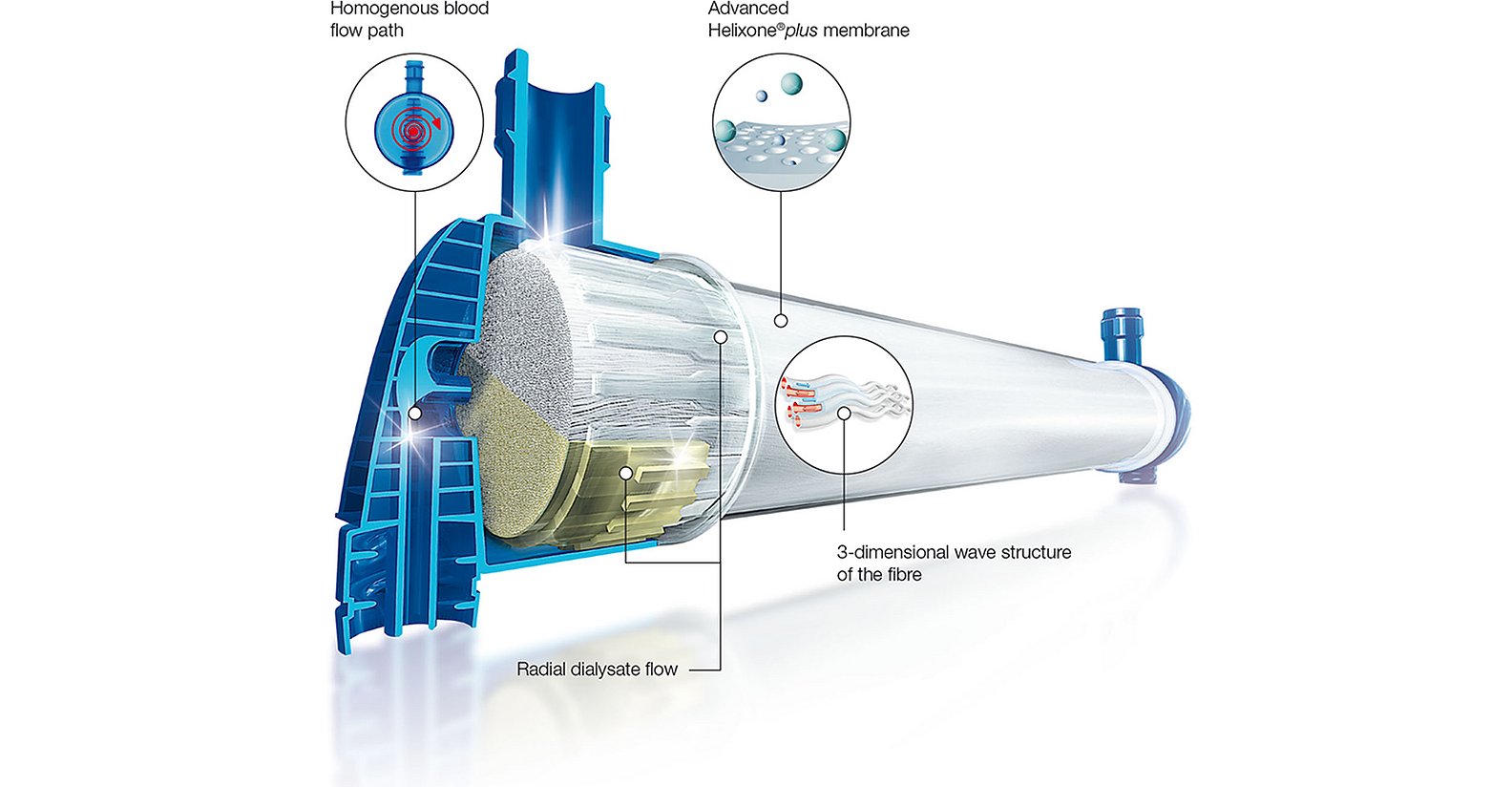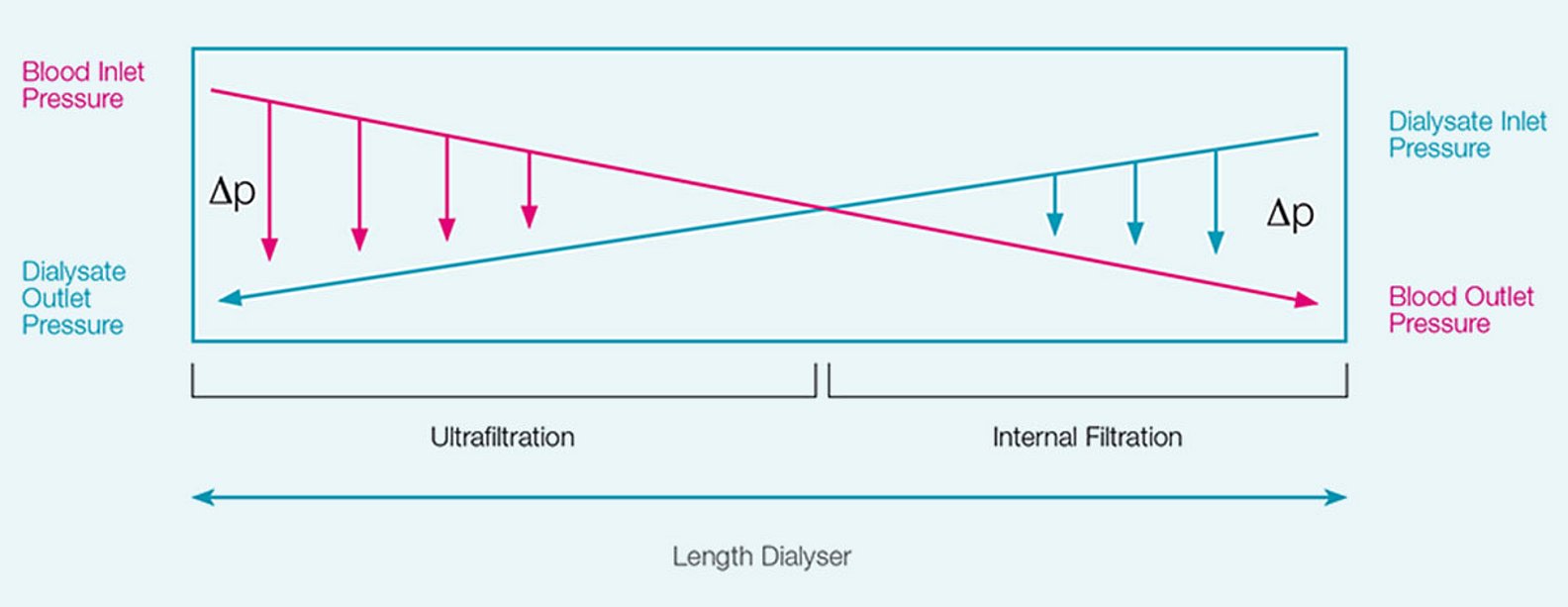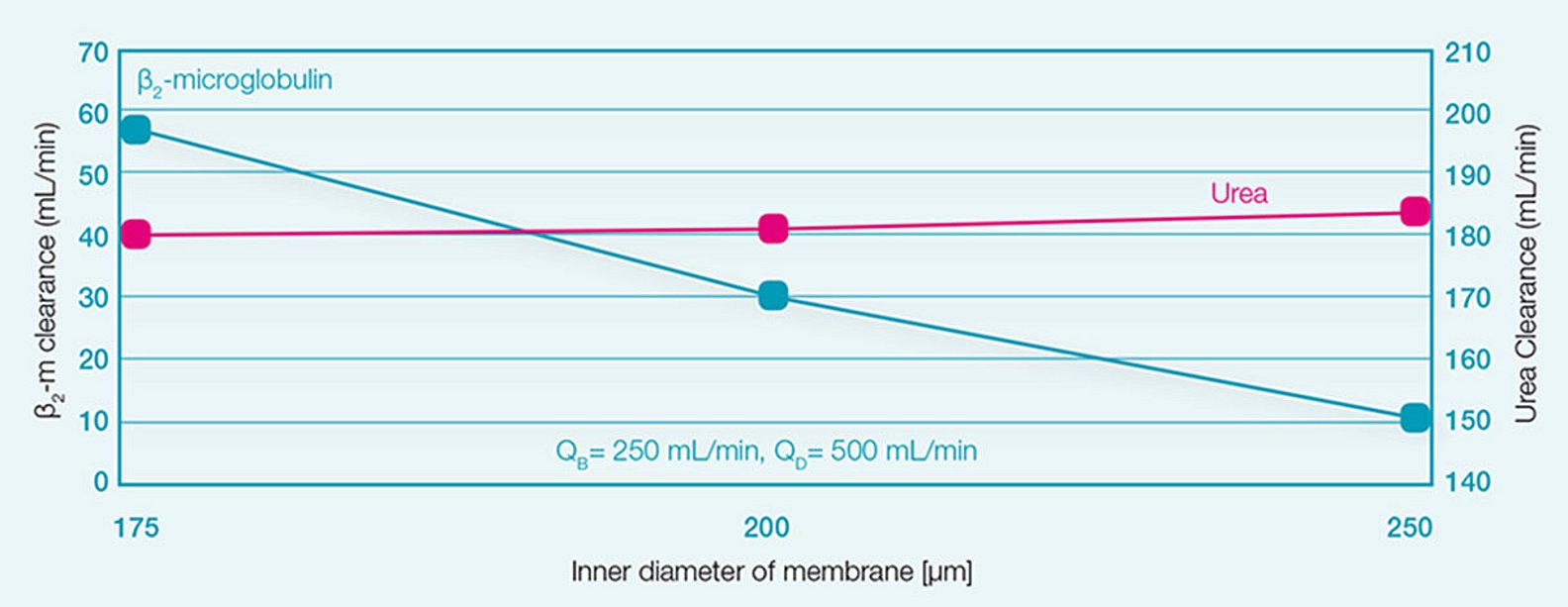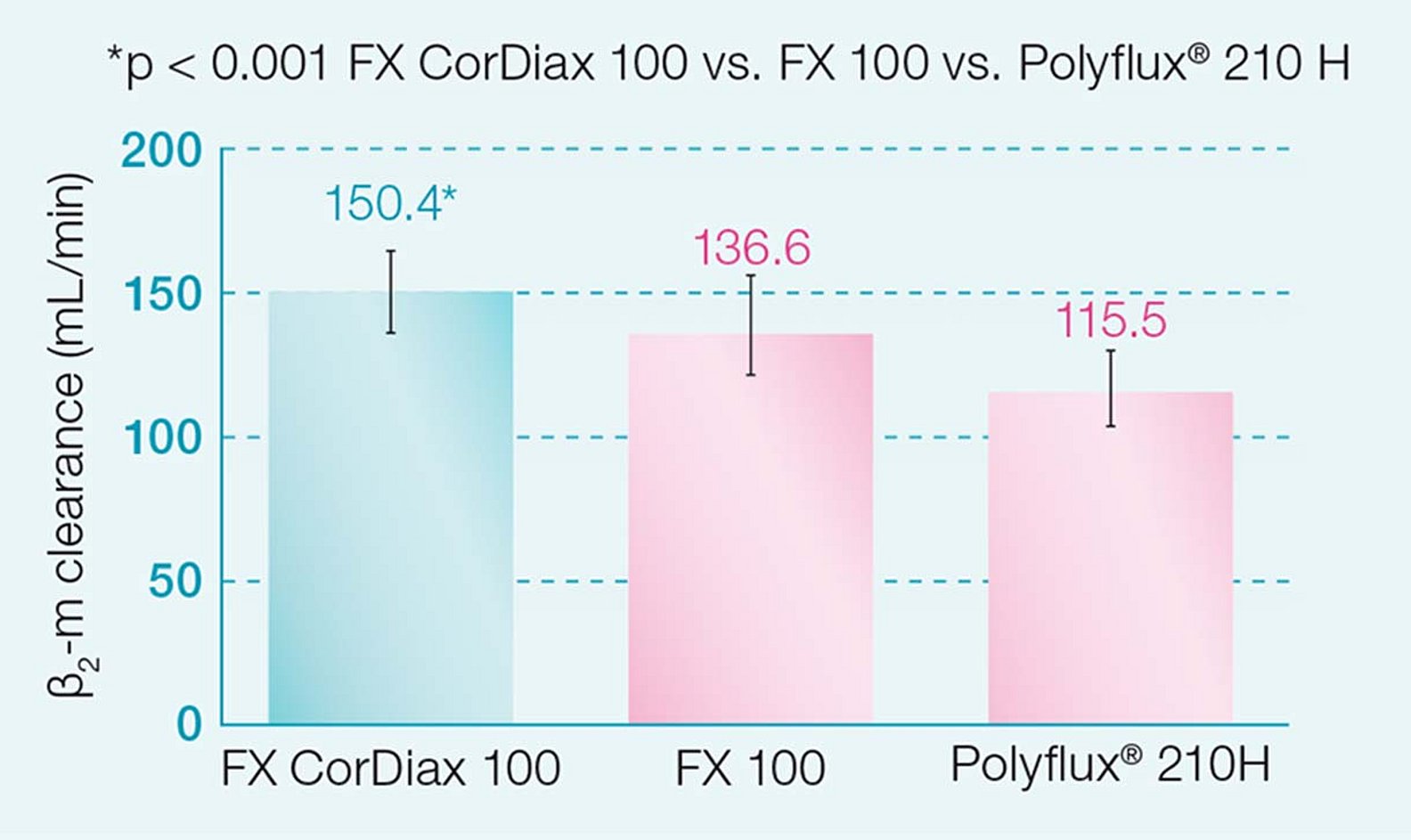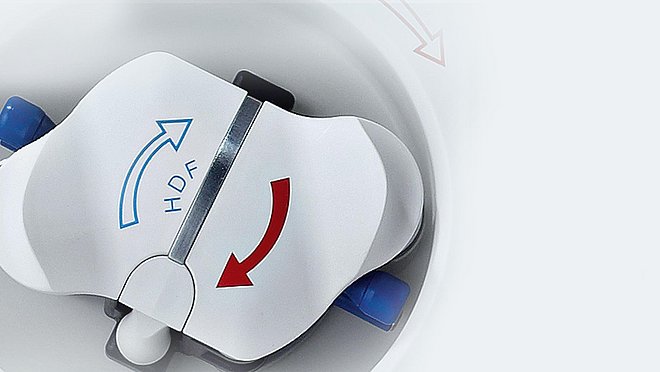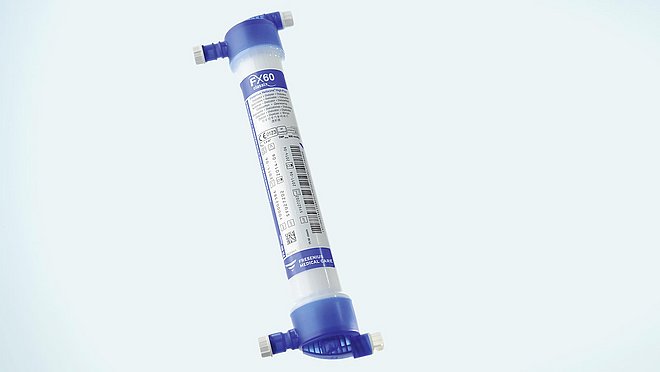FX CorDiax
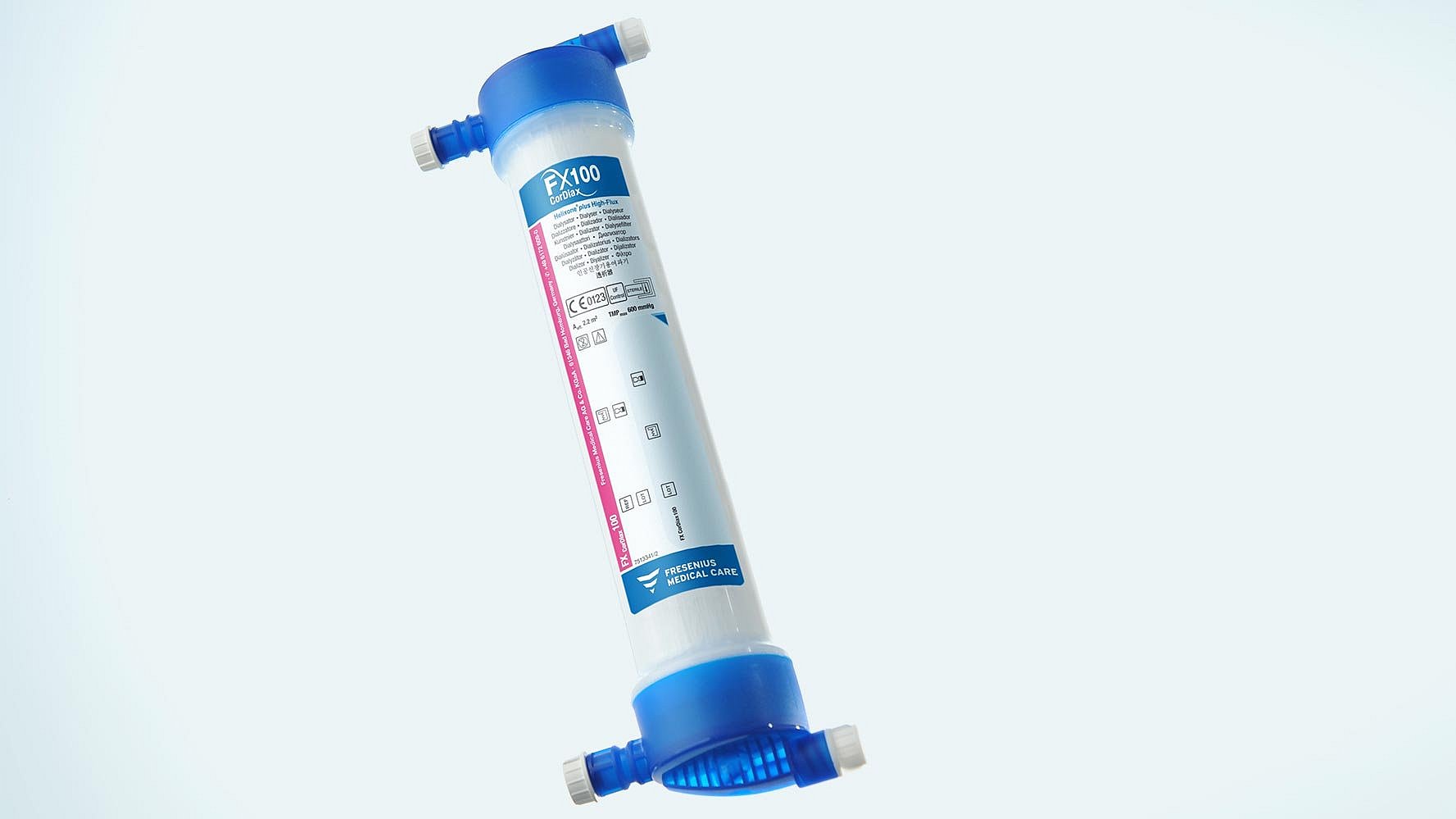
Designed to dialyse
- Efficient middle molecule removal
- INLINE steam sterilised
- Low rinsing volume
High selective permeability for middle molecules
The FX CorDiax is the most efficient dialyser within the FX class®. The core of the FX CorDiax is the Helixone® plus membrane, a targeted enhancement of the Helixone® membrane.
Refined membrane architecture
New production technology combined with INLINE steam sterilisation, allows for crucial enhancements of membrane porosity, reducing flow resistance and improving transport across the membrane.
Benefits of refined membrane architecture
Significantly improved removal of middle molecules while preventing the loss of useful substances, such as serum albumin
Purity enhanced — with steam
| The benefits of INLINE steam sterilisation | |
|---|---|
| No chemical residues | No need for gamma sterilisation: high-energy ionising radiation can degrade and alter the material chemistry |
| Low rinsing volumes | Rinsing time and volume is substantially lower compared to gamma-sterilised dialysers |
| Less rinsing, lower costs | Lower rinsing volumes mean reduced preparation costs |
Advances in fibre design allow for the better removal of uraemic toxins
- The fibre support region underneath the inner surface has been “opened up”, optimising porosity and therefore also the convective filtration (“flushing”) of larger uraemic toxins such as β2-microglobulin (≈ 11,800 Da) or myoglobin (≈ 17,000 Da)
- At the same time, the size of the pores of the inner surface area was not increased to avoid the flushing of albumin
Superior by design
Several state-of-the-art technologies have been combined to create the distinctive, functional features of FX-class® dialysers, which are refined and optimised for performance and handling:
- Design of dialyser housing and fibre bundle for more uniform dialysate flow
- Refined blood inlet port for improved haemodynamics
Advances in material and production technologies have allowed for improvements in the wall structure of the Helixone®plus membrane of the FX CorDiax.
- More porous membrane wall for the higher clearance of middle molecules
| Optimised dialysate flow | The three-dimensional microwave structure of the fibres ensures uniform radial dialysate flow around each fibre within the bundle by preventing fluid channeling, therefore enhancing clearance values and improving the overall performance of the dialyser. |
|---|---|
| Better haemodynamics | The lateral blood-inlet port ensures more homogenous blood flow in the dialyser header, preventing stagnation zones. The design essentially minimises the risk of kinking, contributing to improved safety. |
| Enhanced convection | The more open structure of the Helixone®plus membrane support region serves to reduce diffusion resistance and increases convective filtration. This facilitates the clearance of a broad range of uraemic toxins, especially the middle molecules. |
| Kind to the environment | Advanced design goes beyond direct functionality; it also has to be easy on the environment. FX-class® dialysers weigh half as much as dialysers with polycarbonate housing, and at the same time, use ecologically friendly plastics. This means a lower carbon footprint as a result of fewer materials, less packaging, less fuel for transport and cleaner waste management. |
Key to optimal middle molecule removal
Solutes encounter resistance while traversing the membrane wall. Resistance to solute transport is affected in part by pore size at the inner surface and the porosity of the membrane wall. Furthermore, wall structure and thickness, inner fibre dimensions and three-dimensional microwave structure play important roles in transmembrane flux. The new membrane structure of Helixone®plus allows for the easy passage of middle molecules across the more porous support region of the membrane.
- The structure of the support region is crucial to overall performance
- Membrane porosity, together with the pore size, regulate the transport of middle molecules
Fibre design for HD
In an HD treatment, reducing the inner fibre diameter from 200 μm (F-series) to 185 μm (FX-class®) acts to increase internal filtration, thereby increasing the pressure gradient along the length of the fibre. This results in a greater pressure difference between the blood and dialysate compartments. Together with structural refinements to the support region of the fibres, this enables improvements in both diffusive and convective transport, which is of particular importance when performing High-Flux haemodialysis.
Benefits of the reduced inner fibre diameter
Design of the HD fibre
- A small inner diameter of the hollow fibre increases the pressure gradient between blood and dialysate compartments
- The result is improved clearance of middle molecules such as vitamin B12, inulin, β2-microglobulin and myoglobin1
- The increased pressure gradient, combined with structural refinements to the membrane (support region), enhances diffusive as well as convective filtration, especially when performing High-Flux haemodialysis with FX CorDiax
FX CorDiax haemodiafilter
HighVolumeHDF therapy requires specially designed filters. As a result, FX CorDiax haemodiafilters were developed for HighVolumeHDF
Increased fibre lumens for better flow conditions
- An increase of its inner diameter results in a reduced pressure drop within a hollow fibre
- The capillary diameter of a dialyser can affect performance and treatment quality
- The inner diameter of haemodiafilters is 210 μm, compared to 185 μm in HD filters. The larger diameter facilitates improved flow conditions, allowing for higher convective volumes in an HDF treatment.2
The benefit of enlarged fibre lumen in FX CorDiax haemodiafilters
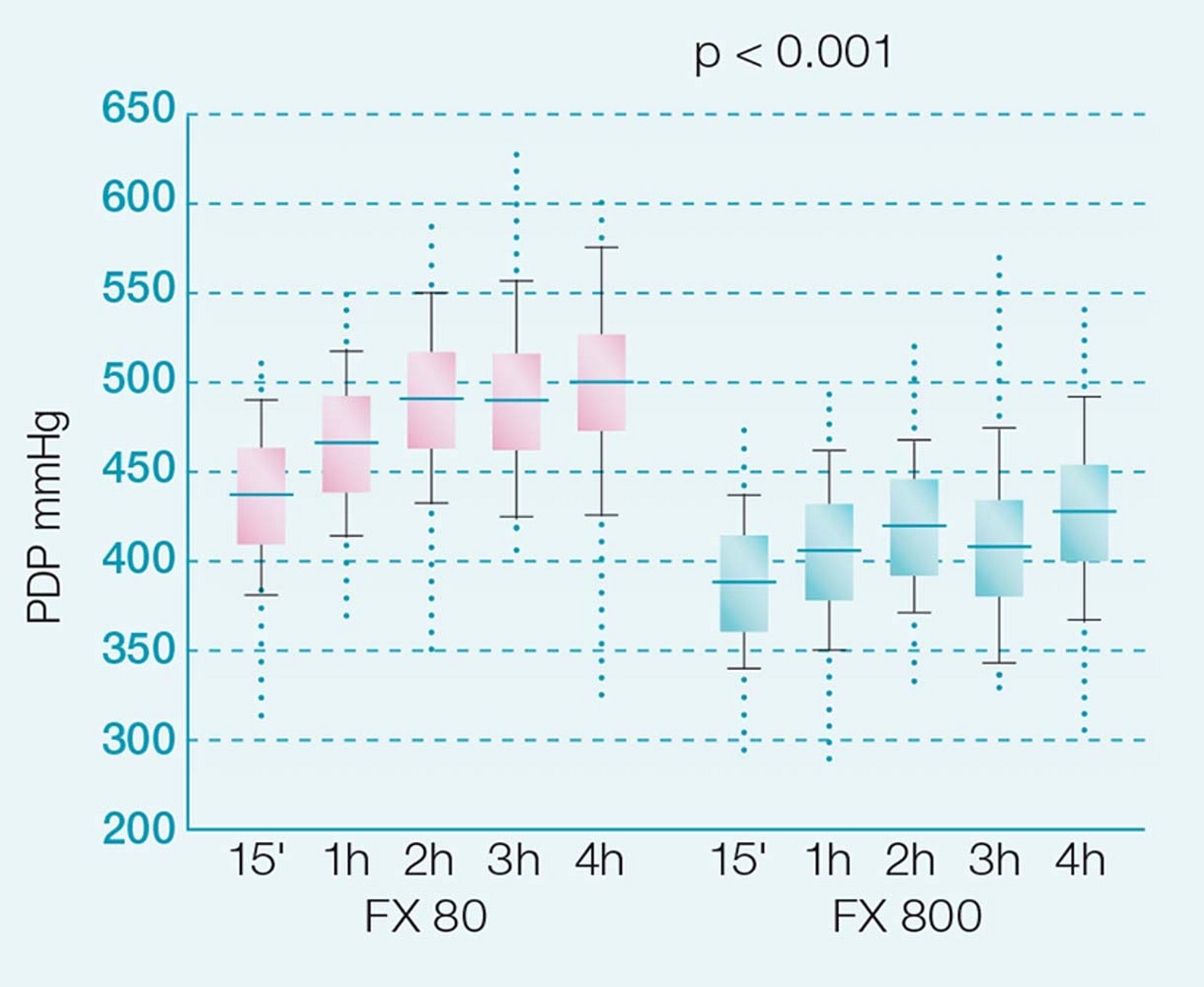
Reduced dialyser inlet pressure of FX 800 (210 μm) vs. FX 80 (185 μm)2 (Graph adapted from the original publication)
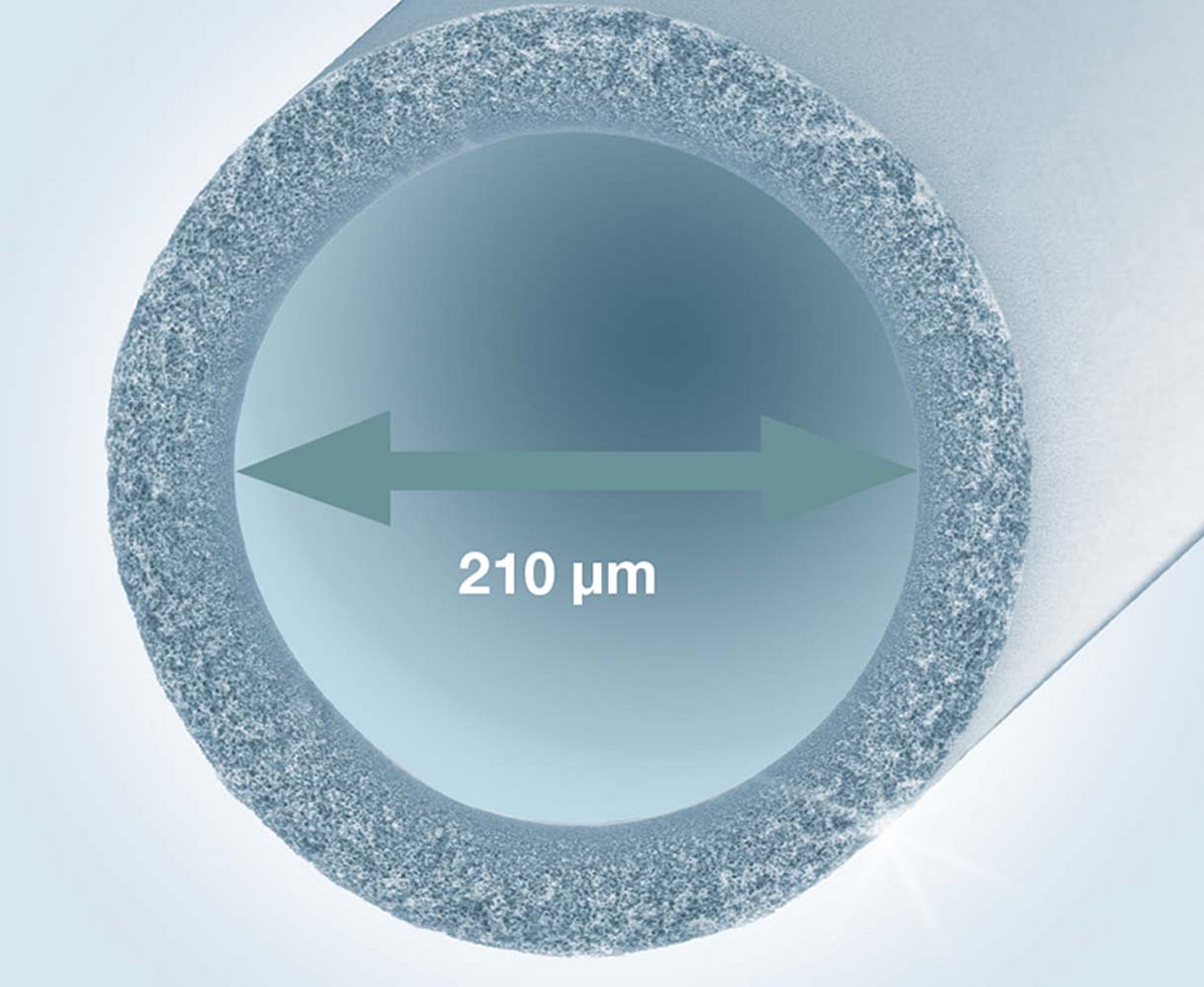
The 210 μm fibre lumen of FX CorDiax haemodiafilters optimises blood flow conditions within the dialyser for maximal HighVolumeHDF performance.
Sieving coefficients of FX CorDiax High-Flux Dialysers and Haemodiafilters
| Sieving coefficients of FX CorDiax High-Flux Dialysers and Haemodiafilters | Molecular weight (Daltons) | |
|---|---|---|
| Albumin | 66,500 | < 0.001 |
| Myoglobin | 17,053 | 0,5 |
| β2-microglobulin | 11,731 | 0,9 |
| Inulin | 5,200 | 1 |
| Membrane material | Helixone®plus | |
| Sterilisation method | INLINE steam | |
| Housing material | Polypropylene | |
| Potting compound | Polyurethane | |
| Units per box | 24 |
FX CorDiax High-Flux Dialysers
| FX CorDiax High-Flux Dialysers | FX CorDiax 40 | FX CorDiax 50 | FX CorDiax 60 | FX CorDiax 80 | FX CorDiax 100 | FX CorDiax 120 | |
|---|---|---|---|---|---|---|---|
| Clearance (QB = 300 ml/min) | Molecular weight (Daltons) | ||||||
| Cytochrome c | 12,230 | 48 * | 76 | 96 | 111 | 125 | 136 |
| Inulin | 5,200 | 56 * | 88 | 116 | 127 | 144 | 149 |
| Vitamin B12 | 1,355 | 96 * | 144 | 175 | 190 | 207 | 213 |
| Phosphate | 132 | 142 * | 215 | 237 | 248 | 258 | 262 |
| Creatinine | 113 | 155 * | 229 | 252 | 261 | 272 | 274 |
| Urea | 60 | 175 * | 255 | 271 | 280 | 283 | 284 |
| Clearance (QB = 400 ml/min) | |||||||
| Cytochrome c | 12,230 | 100 | 117 | 133 | 145 | ||
| Inulin | 5,200 | 122 | 135 | 154 | 160 | ||
| Vitamin B12 | 1,355 | 191 | 209 | 229 | 237 | ||
| Phosphate | 132 | 270 | 285 | 299 | 305 | ||
| Creatinine | 113 | 290 | 303 | 321 | 325 | ||
| Urea | 60 | 319 | 336 | 341 | 343 | ||
| * Clearance (QB = 200 ml/min) | |||||||
| Ultrafiltration coeff. (ml/h x mmHg) | 21 | 33 | 47 | 64 | 74 | 87 | |
| In vitro performance: QD = 500ml/min, QF = 0ml/min, T = 37°C (ISO 8637). Sieving coefficients: human plasma, QBmax, QF = 0.2 x QBmax (ISO 8637). Ultrafiltration coefficients: human blood (Hct 32%, protein content 6%). | |||||||
| Effective surface (m2) | 0,6 | 1,0 | 1,4 | 1,8 | 2,2 | 2,5 | |
| K0A Urea | 547 | 886 | 1,164 | 1,429 | 1,545 | 1,584 | |
| Priming volume (ml) | 32 | 53 | 74 | 95 | 116 | 132 | |
| Article number | F00001588 | F00001589 | F00001590 | F00001591 | F00001592 | F00002384 | |
FX CorDiax Haemodiafilters
| FX CorDiax Haemodiafilters | FX CorDiax 600 | FX CorDiax 800 | FX CorDiax 1000 | |
|---|---|---|---|---|
| Clearance (QB = 300 ml/min, QF = 75 ml/min) | Molecular weight (Daltons) | |||
| Cytochrome c | 12,230 | 131 | 141 | 151 |
| Inulin | 5,200 | 144 | 156 | 166 |
| Vitamin B12 | 1,355 | 204 | 217 | 225 |
| Phosphate | 132 | 257 | 267 | 271 |
| Creatinine | 113 | 271 | 277 | 280 |
| Urea | 60 | 285 | 291 | 292 |
| Clearance (QB = 400 ml/min, QF = 100 ml/min) | ||||
| Cytochrome c | 12,230 | 149 | 160 | 172 |
| Inulin | 5,200 | 166 | 178 | 190 |
| Vitamin B12 | 1,355 | 235 | 251 | 262 |
| Phosphate | 132 | 307 | 321 | 328 |
| Creatinine | 113 | 327 | 339 | 343 |
| Urea | 60 | 354 | 365 | 367 |
| Ultrafiltration coeff. (ml/h x mmHg) | ||||
| In vitro performance: QD = 500 ml/min, T = 37°C (ISO 8637). Sieving coefficients: human plasma, QBmax, QF = 0.2 x QBmax (ISO 8637). Ultrafiltration coefficients: human blood (Hct 32%, protein content 6%). | ||||
| Effective surface (m2) | 1,6 | 2,0 | 2,3 | |
| K0A Urea | 1,148 | 1,365 | 1,421 | |
| Priming volume (ml) | 95 | 115 | 136 | |
| Article number | F00001593 | F00001594 | F00001595 | |
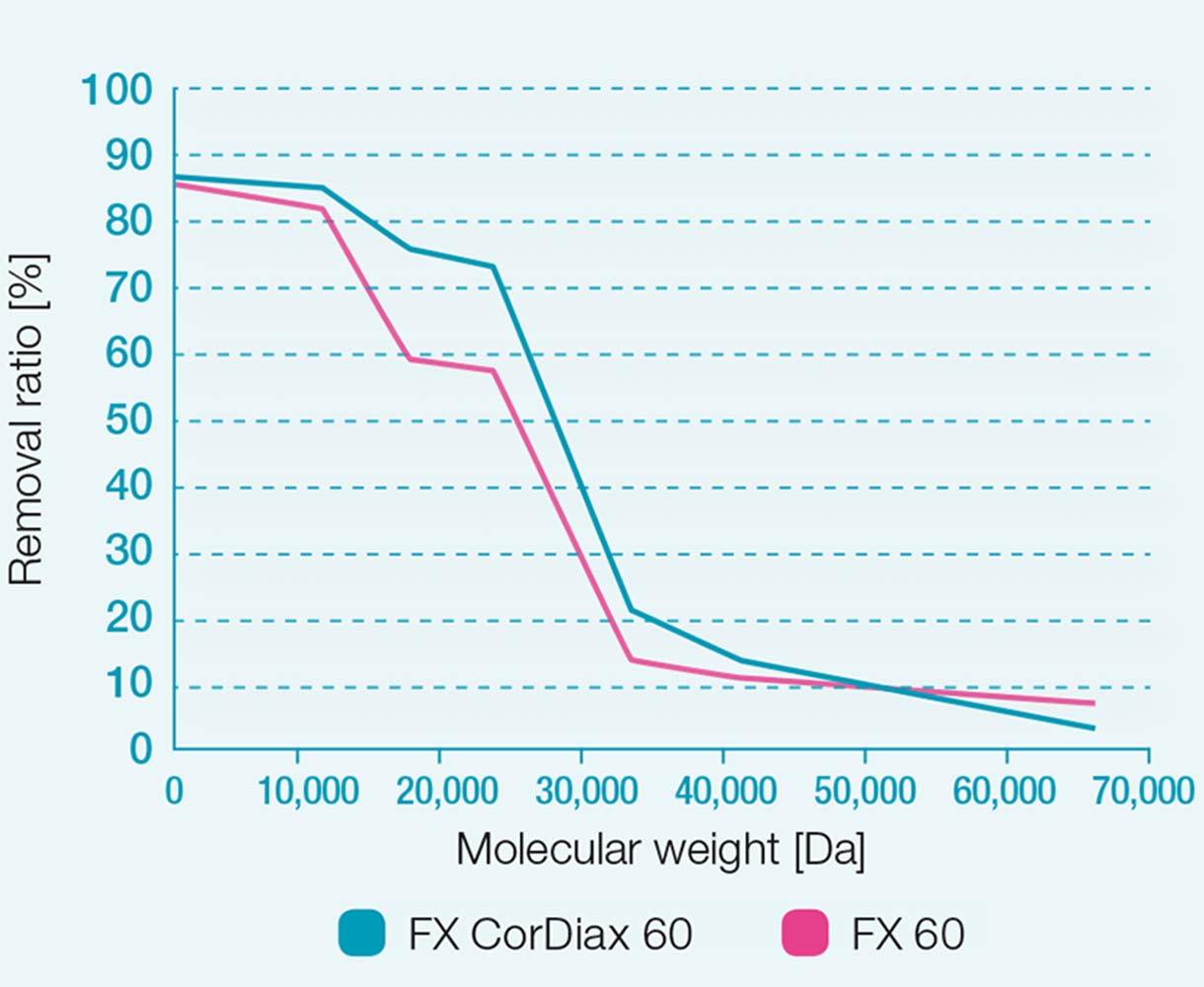
Removal ratios of the FX 60 and FX CorDiax 60 dialysers in postdilution HDF3 (QB = 400 ml/min, QD = 500 ml/min)
FX CorDiax has a high middle molecule removal capacity
Maduell et al. determined the removal capacity of FX CorDiax 60 compared to FX 60 in HDF postdilution treatments. Significantly higher removal rates were observed with FX CorDiax for:
- Urea (60 Da)
- β2-microglobulin (11.8 kDa)
- Myoglobin (17.2 kDa)
- Prolactin (22.9 kDa)
- α1-microglobulin (33 kDa)
The authors concluded that “… treating patients with online hemodiafiltration and FX CorDiax 60 instead of FX 60 dialysers results in significantly increased reduction ratios of middle sized molecules without clinically relevant changes in albumin loss.”
… treating patients with online hemodiafiltration and FX CorDiax 60 instead of FX 60 dialyzers results in significantly increased reduction ratios of middle sized molecules without clinically relevant changes in albumin loss.
In a postdilution HDF treatment, the use of FX CorDiax 100 dialysers resulted in a significantly higher clearance of β2-microglobulin than in FX 100 and Polyflux® 210H dialysers. The albumin loss was low and similar for all dialysers.4
Comparison of albumin loss in a post-dilution HDF treatment
(QB = 350 ml/min, QD = 800 ml/min, QS = 80 mL/min)4
| Albumin loss (g/four hours) | |
|---|---|
| FX CorDiax 100 | 1.74 ± 1.01 |
| FX 100 | 2.10 ± 1.00 |
| Polyflux® 21 OH | 1.31 ± 0.12 |
The phosphate clearance of FX CorDiax dialysers
Comparison of aqueous in-vitro clearances of phosphate (QB = 300 ml/min, QD = 500 ml/min). Investigations carried out by EXcorLab GmbH, an accredited calibration and testing laboratory.
If you would like to order this product via the NHS Supply Chain Catalogue, please visit the following link: NHS Supply Chain Online Catalogue
Additional information relating to multiBic or Calrecia can be found in the critical care section of our product information page.
Adverse Events Reporting
Adverse events should be reported. Reporting forms and information can be found at
https://yellowcard.mhra.gov.uk/ or search for MHRA Yellowcard in the Google Play or Apple app store. Adverse events should also be reported to Fresenius Medical Care on 01623 445100.
UK/HEMA/FME/0922/0005 Date of Preparation: November 2022
1 Dellanna F. et al., (1996); Nephrology Dialysis Transplantation 11 (Suppl 2): 83-86.
2 Vega Vega O. et.al.; ERA-EDTA Congress 2012, Poster 457—FP.
3 Maduell et. al.; ERA-EDTA Congress 2013, May 20, Poster Number MP 390.
4 Bock A. et al., Journal of the American Society of Nephrology (2013); 24: SA-PO404.
